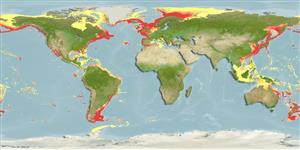Common names from other countries
Environment: milieu / climate zone / depth range / distribution range
Écologie
; saumâtre; profondeur 0 - 1000 m (Ref. 116013). Polar
Atlantic, Pacific, Mediterranean, Arctic and Antarctic. Polar and subtropical.
Length at first maturity / Taille / Poids / Âge
Maturity: Lm ? range ? - ? cm
Description synthétique
Morphologie
Small unfascicled colonies; cnidome comprising only microbasic euryteles; female and male blastostyles completely reduced; immature female gonophore with unbranched spadix (Ref. 3086).
Maximum depth from Ref. 119523. Megabenthic species (Ref. 2952). Found at depths of 1 to 7 m on rocks or living as an epizoite on ascidians, barnacles, mussels, and sponges. Colonial (Ref. 3086). Known from sheltered areas of bays, including mangrove shores and sounds (Ref.86643). Found on the brown alga Cystoseira crinita (Ref. 116447).
Life cycle and mating behavior
Maturité | Reproduction | Frai | Œufs | Fécondité | Larves
Reproduction occurs only in hydroid stage (Ref. 1663, p. 13).
Migotto, A.E., A.C. Marques, A.C. Morandini and F.L. da Silveira. 2002. (Ref. 813)
Statut dans la liste rouge de l'IUCN (Ref. 130435)
statut CITES (Ref. 108899)
Not Evaluated
Not Evaluated
Utilisations par l'homme
| FishSource |
Outils
Plus d'informations
Taille/ÂgeCroissanceLongueur-poidsLongueur-longueurMorphologieLarvesAbondance
Sources Internet
Estimates based on models
Preferred temperature
(Ref.
115969): 5.8 - 25.2, mean 12.1 (based on 3066 cells).
Catégorie de prix
Unknown.
